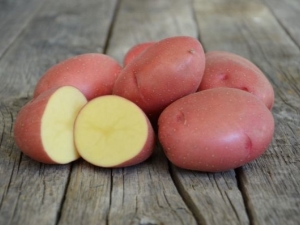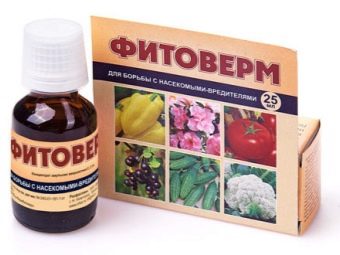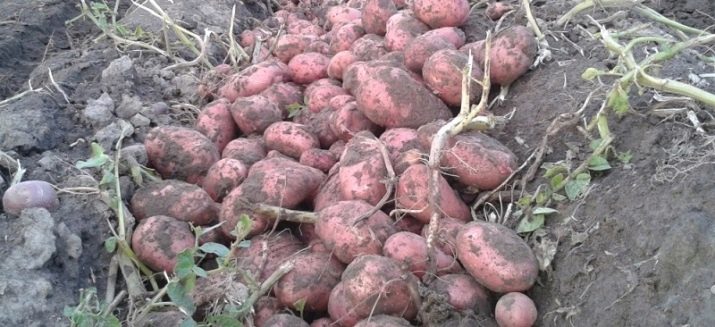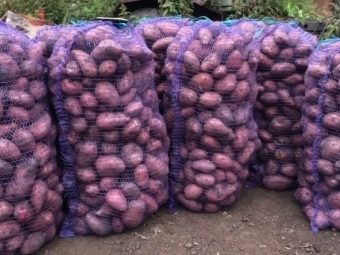Description and cultivation of the potato variety "Rozara"

Potato varieties "Rosara" was bred by German scientists in the 90s. of the last century and literally in a few years came to the domestic food market.This potato is very common in many different countries of the world. For quite a long time, "Rosara" retains leadership in sales, despite the competition from new species and varieties.
Special features
The advantages of the variety "Rozara" are appreciated by many gardeners and gardeners - this unpretentious potato can be cultivated in the most diverse climatic zones. "Rosaru" is distinguished by early ripening, consistently high yield and exceptional taste characteristics. An important advantage is the resistance to various diseases of this potato.
From the moment of planting the seed to the full harvest of mature tubers, 60-70 days pass. Harvesting can be done at the end of August, while up to 24 tubers can be harvested from each bush, the weight of each fruit is 100-150 g. Thus, up to 3.5 kg of strong and tasty potatoes can be obtained from each bush.
The color of the tubers is light pink, making them easy to distinguish from any other varieties. The shape of the tuber is oval, the dimensions are about the same, on the skin there is a slight roughness. The eyes are shallow and very small, the flesh is distinguished by a pale yellow shade. The bushes of the potato "Rosara" are very compact - they are short and not sprawling. Purple bloom with rich yellow stamens. Leaf blade ovoid, color - dark green.
The popularity of the variety is due to its numerous advantages:
- High adaptability - this potato can be cultivated not only in the south of Russia, but also in other regions, with the exception of the northern ones. The variety is not afraid of drought, the potato successfully grows and develops in conditions of high temperature under scorching direct sunlight.
- Precocity. Gardeners in the central part of Russia rarely think about how soon the roots are ripening, but in the Urals and Siberia any summer resident understands that it is much more profitable to plant early ripening varieties, because in their regions summer and autumn do not always come in their calendar dates. That is why in conditions of unstable climate, planting late-ripening varieties often leads to the fact that the tubers simply do not have time to mature before the onset of cold weather.
- Good yield. "Rosara" is distinguished by the fact that it has abundant fruits for a long time. Most often, 2-2.5 kg of potatoes are harvested from each bush, but in conditions of good care this indicator can be much higher.
- Great keeping quality. At least 90% of the fruits have an excellent presentation, withstand transportation and prolonged storage. That is why the variety is chosen not only by summer residents for personal use, but also by large agro-industrial companies that grow potatoes for sale. If the storage conditions correspond to the standard, then the fruits are kept in a dry room at a temperature of +2. +5 degrees, the damage does not exceed 2%. And in terms of typical basements and cellars, this figure does not exceed 10%.
- Good taste. Potato "Rosara" is characterized by a pleasant taste, experts estimate it at 4.5 on a 5-point scale.
Potatoes are recommended to boil and bake. It is used for making soups, as well as main dishes and vegetable salads.
However, it was not without drawbacks:
- potatoes have poor resistance to late blight;
- bushes crawl in different directions;
- the grade is not suitable for frying.
Taste qualities
The most important factor affecting the prevalence of a potato variety, like any other vegetable, is its taste characteristics. This is not surprising, because the potatoes are grown to eat, and everyone wants to eat delicious.
"Rosara" is very tasty, soft and tender, and the pulp is not watery. At the same time, thanks to the yellow tint, both boiled potatoes and mashed potatoes look exceptionally appetizing.It is very important that when cooking the tubers do not boil soft, therefore they are often used for making salads, when the boiled fruit is cut into small cubes or grated.
The absence of starch is considered a particularly valuable quality, thanks to which dishes with it are redundant in sweetness and closeness, and in addition, it makes it possible for people on diets and young children to eat potatoes.
Landing
Despite the exceptional quality of the Rosara potato, the taste and the increased yield of the variety remain unchanged during vegetative reproduction for 4-6 years, over time any soil is very depleted, pathogenic microorganisms and fungi spores grow in it.
This makes it impossible to maintain the yield of plants and the safety of tubers at the proper level, even with the best care.
Of course, in special stores at any time you can buy new tubers, but there the planting material of this variety is not cheap. This is especially noticeable if it becomes necessary to replace the planting tubers completely and buy new ones in large quantities.
In this case, the cultivation of tubers from seeds will be a good way out; however, this process is rather long - it stretches for two years. It is important to have this in mind and to attend to the purchase of seeds in advance. In this case, obtaining a new material for planting will be much cheaper.
In addition to the low price, the method has many other advantages:
- Confidence in the high quality of potatoes - not every gardener who buys potatoes on the market can “truly” identify his variety and distinguish the superelite (which includes “Rosara”) from ordinary small pink potatoes.
- Maintaining a high level of seed germination over a long period of time. Gardeners recommend planting seeds no later than 3 years after they were received, but with proper storage they retain their vitality much longer - their shelf life reaches 10 years.
- Self-grown mini-tubers do not need specific storage conditions and take up little space — much less than standard planting material.
- Increased yield. It is noticed that the size of the harvest obtained in this way is 10-15% higher. However, this indicator is greatly influenced by the climate in each specific region.
- The absence of diseases characteristic of the potato variety - this is because the seeds and tubers do not inherit the disease from the bush grown in natural conditions.
However, nothing perfect has yet been invented, therefore the seed method of growing tubers has its drawbacks:
- Seeds have a low germination ratetherefore, they will have to be prepared with a rather large margin.
- Capriciousness of seedlings - potato seedlings are very fastidious, it requires almost perfect conditions for planting and growing: the bushes stretch strongly when there is a shortage of solar or artificial light, wither away with a lack of nutrients, and when diving their root system often dies.
- Exposure to the black leg. Unfortunately, cultivation in artificial conditions does not make the plants absolutely resistant to diseases, seedlings are still affected by some of the ailments.
- Long waiting period. The method, frankly, is not for hurried ones - it takes almost two months between the emergence of the first shoots and the transplant into the soil, while the seedlings are stretched to 17 cm. At the same time, the stem itself is thin and weak, so not everyone can bear their weight . Seedlings often bend, nick and deform.
In addition, one should not forget that it will not be possible to get a full-fledged harvest right away - in the first year, only mini-tubers can be harvested, which already in the second season are planted in the ground and produce strong, large, suitable for eating fruits.
Regardless of whether you grew mini-tubers yourself or used seed from previous years, there are certain requirements for seed tubers. They must be sturdy and even without any visible defects. Any growths, cracks and browning can be a sign of a fungal infection. Such a tuber should be immediately put off.
After the seed potatoes are selected, it is placed in a dark place for germination, the air temperature in this room should not exceed 4 degrees, direct ultraviolet rays are strictly not allowed.
Many plant tubers without sprouting, but in this case, the growing season is 7-14 days longer.
As soon as the buds come to life, the tubers should be poured with shavings or sawdust, forming a layer about 4 cm in size. Spray should be regularly sprayed with a solution of prepared biostimulants. Optimal for "Rosary" compositions are considered to be the preparations "Mikon" and "Epin."
Sprouting planting tubers should begin 1.5 months before the expected date of landing in the ground. Approximately 2 weeks before planting, germinated tubers should be brought to fresh air in order for their skin to become juicy and resistant to adverse environmental influences. This allows you to significantly improve the performance of yields - usually as a result of hardening, it increases by 15%.
The variety is planted after the threat of night frost has passed and the soil warms to 10-15 degrees.
Potato "Rosara" is picky about the composition of the soil, so most often a piece of land for cultivation is distinguished according to the residual principle. However, it should be noted that the plant prefers warm and bright sunlight, so the area should be well lit and without shading. It is optimal if there is any obstacle at a small distance from it, protecting plants from drafts and gusts of wind. It can be shrubs either a fence or a wall of an economic structure.
For planting "Rozary" are not suitable areas located in the lowlands, where long held snow and melt water. Also, do not plant potatoes on the ground with highly located groundwater.
Land for "Rosary" should be fertile, well-fertilized and at the same time very loose. The culture develops best in loam or sierozem. Do not plant potatoes in the soil with high acidity.
"Rose" py is grown on the same site for no more than 3 years, with each new place it is desirable to properly prepare. For this purpose, green man plants are planted on it for the year, which significantly improve the structure of the soil: buttercup, clover, flax or lupine. The best precursors for potatoes are legumes, as well as cucumbers, pumpkins, cabbage or corn.
Potatoes are undesirable to plant after any plants of the family of nightshade, as well as after sunflower, because these crops are subject to the same diseases. Potato "Rosara" planted since mid-April - a more accurate planting date determined on the basis of weather conditions.
Before planting the land is watered with boiling water and covered with black plastic wrap for several days.
Care
"Rosara" is a rather unpretentious variety, so caring for it does not require much effort.
One of the main components of this variety agrotechnics - making feedings. "Rosara" has a great need for potassium and phosphorus, as well as nitrogen. Like other members of the nightshade, potatoes respond well to organic fertilizers - mullein, compost and wood ash.
For the season should be carried out three dressings - at the very first hilling, a week after flowering, and a month later they carry out the third dressing.
The bed must be weeded and removed regularly, and the removal must be deep - so that the roots do not remain inside the ground, as they hinder the active growth and maturation of the tubers.
It is advisable to mulch between rows with straw or mowed grass - this will preserve the required level of moisture in the ground. Every time after a rain or watering, the land needs to be loosened, otherwise it will crack or crust, which prevents air from reaching the tubers.
Like any other potato, "Rosara" requires hilling. It is carried out twice: when the tops grow by 15-20 cm and a couple of weeks after that.
Potatoes are watered about three times per season, but if the summer is dry, then this procedure is carried out a little more often. Particular attention should be paid to moisture during flowering. It is advisable to water it drip or rain so that the bed does not turn into a swamp - in such an environment it is likely that the tubers will simply rot. Each bush requires an average of 4-5 liters of water.
Approximately 10-14 days before harvesting, it is necessary to mow all the tops, thanks to which the tubers of new potatoes will finally be formed. Some gardeners recommend another way - they break up the shoots that have reached a height of 20-25 cm at a distance of 10-15 cm from the ground, so that they do not dry up, but they could not straighten out. In this case, the nutrients from the soil enter the stem, reach a break and unfold, carrying the necessary micro and macronutrients to the tubers.
Diseases and pests
The most famous potato pest is the Colorado potato beetle. It devours the stems and leaves, which ultimately leads to the death of the plant and the cessation of tuber growth. As a result, yield is sharply reduced.
The beetle is dangerous because of its fertility - one female lays up to 300 eggs, while in the course of a season she can make 3 clutches. Thus, quite quickly, several beetles turn into a huge colony, which negates all the efforts of farmers to obtain a good harvest.
"Rosara" is often subjected to attacks of the Colorado potato beetle, so the gardener should always have at hand means that help destroy the pest. Best suited for this "Colorado", "Bicol" or "Fitoverm." These are products of biological protection that are absolutely harmless to humans. They have a paralyzing effect on the larvae, as a result of which the latter cease to feed and after a short time die. At the same time, beetle eggs are not susceptible to the preparations, therefore spraying should be repeated periodically.
Chemicals have a more serious effect, but their use must be carried out in strict accordance with the instructions. Otherwise, you can cause serious damage to the environment and your own health. Working with chemicals requires the use of protective equipment - gloves and respirator.
Many summer residents in the old-fashioned way are fighting the beetle by hand - that is, they collect both the beetle and its larvae with their hands, put it in a jar and pour boiling water on it. This method is optimal if you grow a couple of beds, but if the area is large, then the mechanical destruction of the Colorado potato beetle will not have any effect, but it will take a lot of work.
Since ancient times in Russia used folk remedies to combat pest. Many use them to this day, because they combine good efficiency with total environmental safety.
The most common options are:
- spraying infusion of birch coal;
- use the ash solution and laundry soap - for this, boil the ash force, insist 2-3 days, and then add a little rubbed soap into the composition;
- spreading onion peel in the middle of the beds;
- growing in between rows of calendula.
Some stick sliced onions near the bushes - a sharp smell is unpleasant for beetles and they try to avoid such places.
Storage
When it comes to potatoes, it is not enough to get a good harvest, it is very important to keep it.As you know, early potato varieties do not have good keeping quality, but Rosara is an exception. When stored in standard conditions, no more than 10% of the crop spoils, and in a dry cool cellar, at least 98% of the fruits retain their presentation.
In order for as many tubers as possible to keep their external characteristics, taste and nutrients, unchanged, it is important that the fruits are fully ripe. After collection, they must be dried in the open air. You should not do this under the scorching sun, it is optimal to find a place for them in the shade, otherwise the tubers will turn green and become unsuitable for human consumption.
Then the potatoes are sorted according to the quality of the tubers. Fruits with visible defects are discarded or used for food immediately. Long-term storage of potatoes only without any mechanical damage.
Fruits with signs of disease cannot be eaten, they must be immediately destroyed.
When arranging the storage room, try to equip it so that the temperature in it is set at 2-4 degrees, and the humidity should not exceed 85%. Only in this case, the crop will be provided with maximum safety.
For storage, take wooden boxes, but you can use mesh bags. At the bottom of the repository, it is advisable to pour rubble or sand, which during the autumn-winter period absorbs excess moisture and reduces the risk of fungal infections. The room should be darkened. Direct sunlight and prolonged artificial light are not allowed.
Keep in mind that rats and mice quite often get into any food storage, therefore it is advisable to decompose the poison in advance.
Recommendations
Each gardener chooses for cultivation the potato variety that best meets his nutritional needs and commercial goals. Potato "Rosara" in this sense can be considered universal, because it is grown for personal use and for sale.
Today, Rosaru is grown everywhere not only in Russia, but also in Kazakhstan, Ukraine and Belarus, with the most positive reviews about it.
Most of the dacha residents point to the exceptional taste of the fruit, the unpretentiousness of the crop, the good tolerance of transportation and the duration of storage. The plant has a high yield.
The only difficulty that gardeners note is related to the early ripening dates - they coincide with the ripening of other popular garden crops, so there is often not enough time to harvest potatoes. In addition, the product is not used for frying - this is also a minus, although mashed potatoes and boiled potatoes from "Rozara" are the most delicious.
In the next video you will find a description of the popular potato variety "Rosara".











































